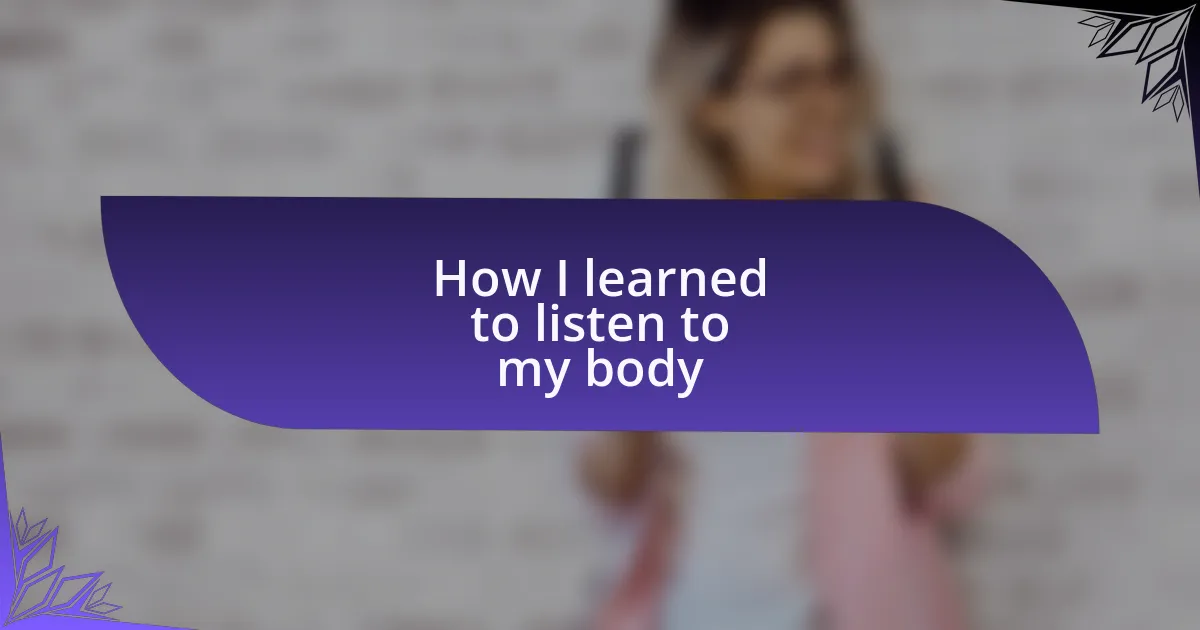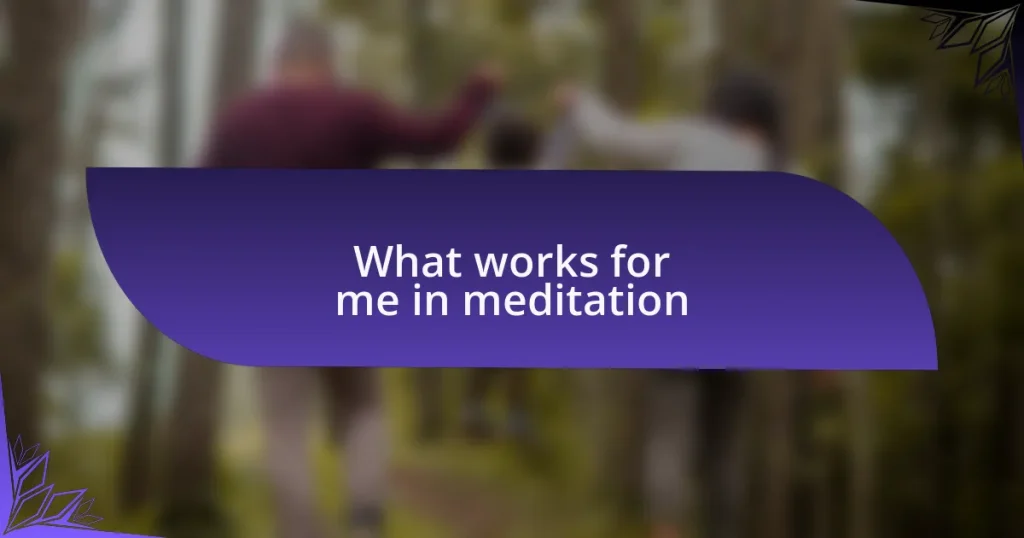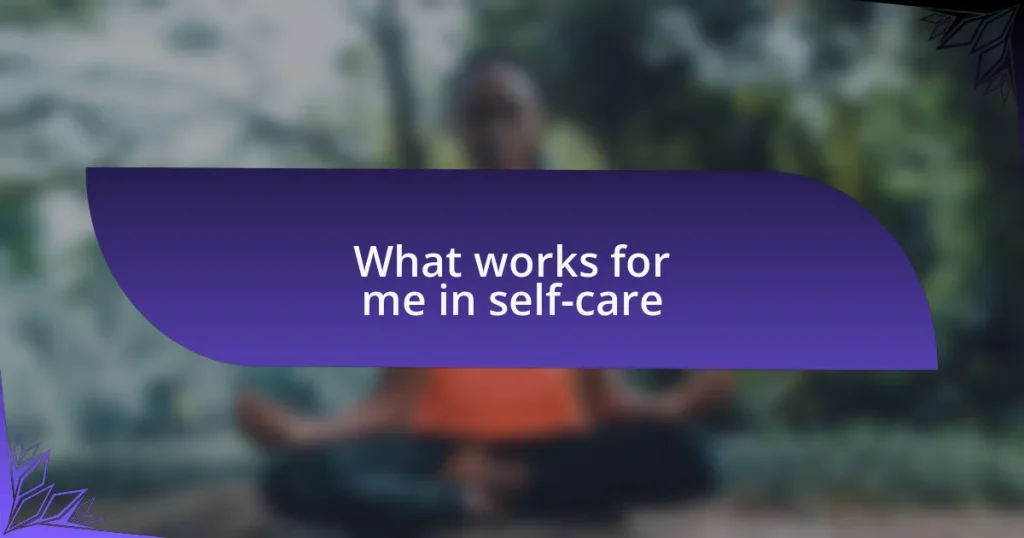Key takeaways:
- Body awareness is crucial for understanding physical and emotional states, leading to better self-care.
- Listening to the body’s signals can prevent exhaustion and enhance emotional clarity.
- Practicing mindfulness through routines, journaling, and self-check-ins fosters deeper connections with one’s body.
- Acknowledging small signals of anxiety can transform one’s approach to challenges and promote a sense of freedom.
Author: Charlotte Pembroke
Bio: Charlotte Pembroke is a contemporary fiction author known for her evocative storytelling and richly developed characters. With a background in psychology, Charlotte weaves intricate narratives that explore the complexities of human relationships and the nuances of everyday life. Her debut novel, The Unfolding Light, garnered critical acclaim for its poignant exploration of grief and resilience. When she’s not writing, Charlotte enjoys hiking in the serene landscapes of her native Oregon, where she draws inspiration for her stories. She currently resides in Portland with her two rescue dogs and a growing collection of vintage typewriters.
Understanding body awareness
Body awareness is often overlooked, yet it is fundamental to understanding how we feel physically and emotionally. I remember a time when I pushed through a grueling week without listening to the signals my body was sending me—exhaustion, tension, and even a nagging headache. It wasn’t until I took a moment to pause that I realized these symptoms were my body’s way of communicating its need for rest and self-care.
When I embrace body awareness, it’s like uncovering a hidden dialogue between my physical state and my mental well-being. This connection is not always easy to recognize; have you ever found yourself ignoring discomfort, thinking it will just go away? I used to believe that powering through was a mark of strength, but I’ve learned that true strength lies in acknowledging what my body needs—whether it’s a leisurely walk, a few deep breaths, or simply a moment of silence.
Developing body awareness requires patience, but the rewards are profound. I’ve found that tuning into my body teaches me to trust its instincts—when I feel anxious or restless, it’s often a signal to reassess my situation. Each time I connect with these feelings, I cultivate a deeper understanding of myself, transforming my relationship with my body into one of cooperation instead of conflict.
Signs your body communicates
When I started to really pay attention, I noticed that my body often gave me early warnings about my emotional state. For example, I would find my shoulders tightening and my jaw clenching during stressful moments, almost like a physical manifestation of anxiety. It was a lightbulb moment when I realized these signs were invitations to take a step back and breathe—simple but effective actions that helped me regain my equilibrium.
There have been days when I’ve ignored the subtle hints, only to be hit with fatigue that felt heavier than a blanket. I’d sometimes think, “Why am I so drained?” only to realize later that my body was pleading for a break. Each time I listened and allowed myself downtime—be it a cozy afternoon reading or a gentle yoga session—I discovered a renewed energy and clarity, almost like hitting a reset button. Isn’t it fascinating how our bodies can guide us, provided we’re willing to engage in that dialogue?
Sometimes the signs are more intense; a headache or stomach discomfort, for instance, can indicate deeper emotional struggles. I recall a time when I experienced persistent stomach issues, which turned out to be tied to unprocessed stress. Reflecting on these experiences, I began to understand the importance of addressing not just the symptoms, but also the underlying feelings. How often do we dismiss these messages from our bodies instead of exploring what they truly mean?
Practical steps to enhance awareness
One practical step I found invaluable is to build a routine of mindfulness. I began setting aside just ten minutes a day to sit in silence, focusing on my breath and how my body felt in that moment. It was surprising how much clarity surfaced—suddenly, the tension in my neck screamed for attention, and that gentle ache in my back revealed how I often slouch when stressed. Have you ever taken that time just for yourself?
Another technique that enriched my body awareness was journaling about my experiences. I’d jot down not only what I felt physically but also how those sensations linked to my emotions throughout the day. This practice opened my eyes to patterns—like how a busy week often left my shoulders feeling tight. When I reflected on those entries, I realized that making time for self-care could prevent those physical manifestations from surfacing. How often do we really connect the dots between our feelings and physical state?
I also learned to check in with my body during everyday activities, like taking a brief pause while working. I’d ask myself, “What is my body telling me right now?” This simple question often prompted running water or a quick stretch, revealing tightness or fatigue I had ignored. I’ve come to realize that these moments of attention create a deeper connection with myself. How empowering it is to acknowledge those messages as they arise!
My personal journey to mindfulness
In my journey toward mindfulness, I discovered that simply paying attention was an act of self-love. I vividly remember moments when I would ignore the slight flutter of anxiety in my chest before a big meeting, chalking it up to normal nerves. However, I learned to pause and breathe deeply, which not only eased my mind but also transformed my approach to challenges. Have you ever noticed how acknowledging those small signals can change the game?
I also found that bringing mindfulness into my daily routine was crucial. For example, during a walk in the park, I made it a point to truly notice my surroundings—the rustle of leaves, the cool breeze against my skin. Each sensory detail connected me to the present moment, pulling me away from my racing thoughts. It’s fascinating how our environments can ground us, isn’t it?
As I deepened my mindfulness practice, I became more attuned to my body’s rhythms. I’ll never forget the first time I consciously chose to rest instead of pushing through fatigue. It felt like a small rebellion against my own expectations, yet it gave me a profound sense of freedom. Isn’t it amazing how listening to our bodies can reclaim our energy and joy?



